BMW M3 COUPE 2001 E46 Owner's Guide
Manufacturer: BMW, Model Year: 2001, Model line: M3 COUPE, Model: BMW M3 COUPE 2001 E46Pages: 183, PDF Size: 1.65 MB
Page 21 of 183
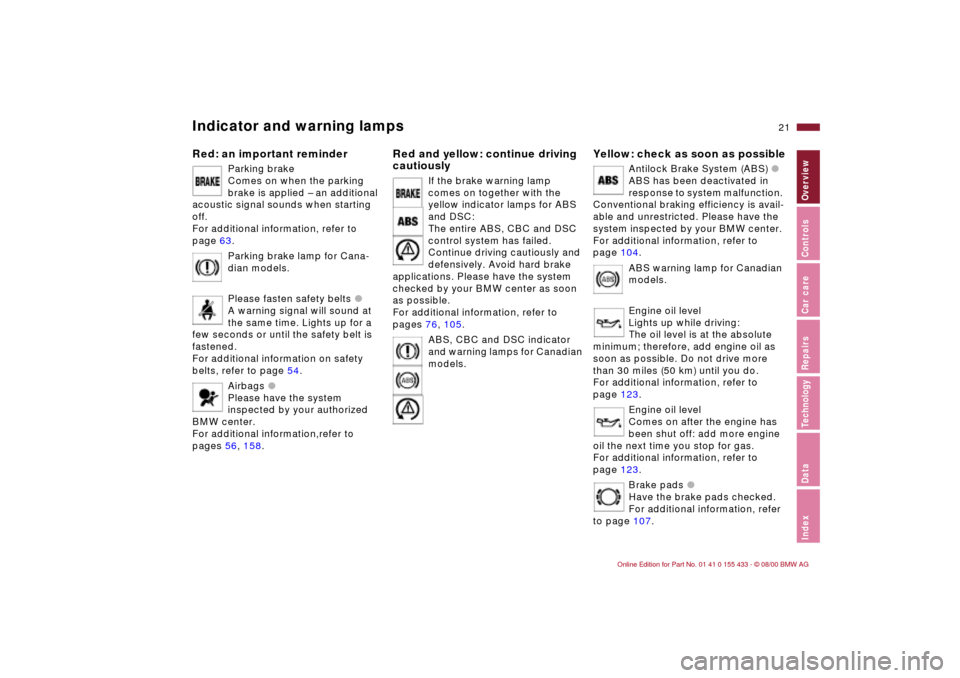
21n
IndexDataTechnologyRepairsCar careControlsOverview
Indicator and warning lamps
Red: an important reminder
Parking brake
Comes on when the parking
brake is applied Ð an additional
acoustic signal sounds when starting
off.
For additional information, refer to
page 63.
Parking brake lamp for Cana-
dian models.
Please fasten safety belts
l
A warning signal will sound at
the same time. Lights up for a
few seconds or until the safety belt is
fastened.
For additional information on safety
belts, refer to page 54.
Airbags
l
Please have the system
inspected by your authorized
BMW center.
For additional information,refer to
pages 56, 158.
Red and yellow: continue driving
cautiously
If the brake warning lamp
comes on together with the
yellow indicator lamps for ABS
and DSC:
The entire ABS, CBC and DSC
control system has failed.
Continue driving cautiously and
defensively. Avoid hard brake
applications. Please have the system
checked by your BMW center as soon
as possible.
For additional information, refer to
pages 76, 105.
ABS, CBC and DSC indicator
and warning lamps for Canadian
models.
Yellow: check as soon as possible
Antilock Brake System (ABS) l
ABS has been deactivated in
response to system malfunction.
Conventional braking efficiency is avail-
able and unrestricted. Please have the
system inspected by your BMW center.
For additional information, refer to
page 104.
ABS warning lamp for Canadian
models.
Engine oil level
Lights up while driving:
The oil level is at the absolute
minimum; therefore, add engine oil as
soon as possible. Do not drive more
than 30 miles (50 km) until you do.
For additional information, refer to
page 123.
Engine oil level
Comes on after the engine has
been shut off: add more engine
oil the next time you stop for gas.
For additional information, refer to
page 123.
Brake pads l
Have the brake pads checked.
For additional information, refer
to page 107.
Page 22 of 183
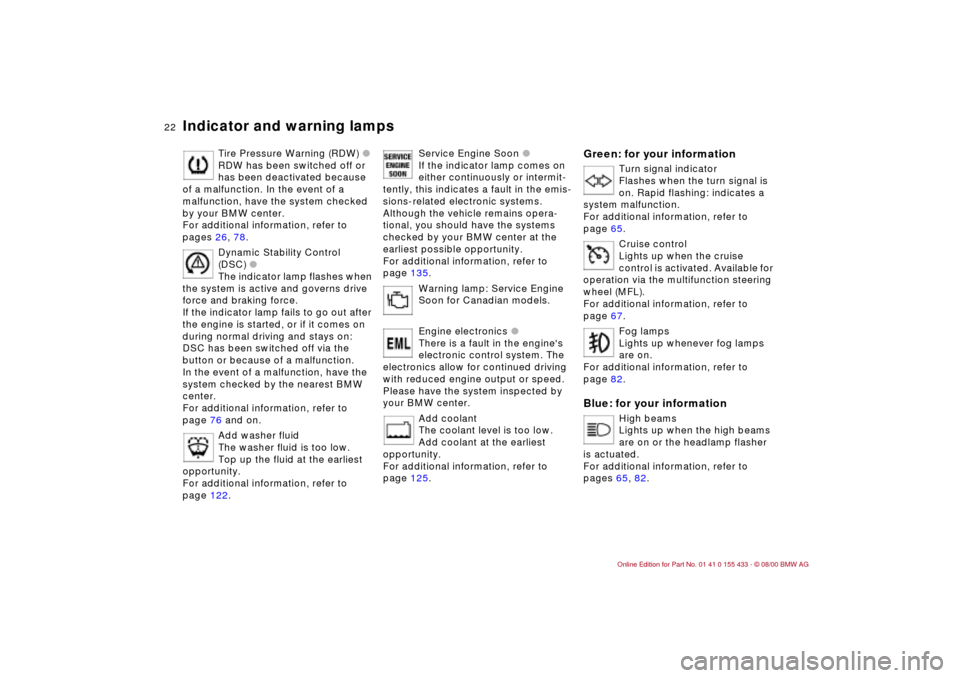
22n
Indicator and warning lamps
Tire Pressure Warning (RDW) l
RDW has been switched off or
has been deactivated because
of a malfunction. In the event of a
malfunction, have the system checked
by your BMW center.
For additional information, refer to
pages 26, 78.
Dynamic Stability Control
(DSC) l
The indicator lamp flashes when
the system is active and governs drive
force and braking force.
If the indicator lamp fails to go out after
the engine is started, or if it comes on
during normal driving and stays on:
DSC has been switched off via the
button or because of a malfunction.
In the event of a malfunction, have the
system checked by the nearest BMW
center.
For additional information, refer to
page 76 and on.
Add washer fluid
The washer fluid is too low.
Top up the fluid at the earliest
opportunity.
For additional information, refer to
page 122.
Service Engine Soon l
If the indicator lamp comes on
either continuously or intermit-
tently, this indicates a fault in the emis-
sions-related electronic systems.
Although the vehicle remains opera-
tional, you should have the systems
checked by your BMW center at the
earliest possible opportunity.
For additional information, refer to
page 135.
Warning lamp: Service Engine
Soon for Canadian models.
Engine electronics l
There is a fault in the engine's
electronic control system. The
electronics allow for continued driving
with reduced engine output or speed.
Please have the system inspected by
your BMW center.
Add coolant
The coolant level is too low.
Add coolant at the earliest
opportunity.
For additional information, refer to
page 125.
Green: for your information
Turn signal indicator
Flashes when the turn signal is
on. Rapid flashing: indicates a
system malfunction.
For additional information, refer to
page 65.
Cruise control
Lights up when the cruise
control is activated. Available for
operation via the multifunction steering
wheel (MFL).
For additional information, refer to
page 67.
Fog lamps
Lights up whenever fog lamps
are on.
For additional information, refer to
page 82.
Blue: for your information
High beams
Lights up when the high beams
are on or the headlamp flasher
is actuated.
For additional information, refer to
pages 65, 82.
Page 23 of 183
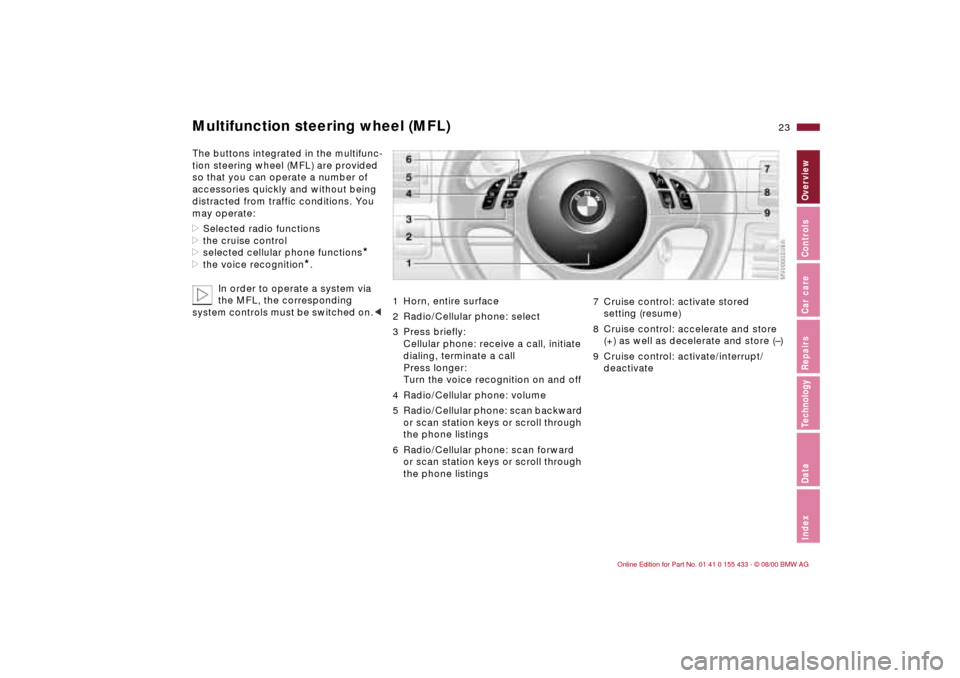
23n
IndexDataTechnologyRepairsCar careControlsOverview
Multifunction steering wheel (MFL)
The buttons integrated in the multifunc-
tion steering wheel (MFL) are provided
so that you can operate a number of
accessories quickly and without being
distracted from traffic conditions. You
may operate:
>Selected radio functions
>the cruise control
>selected cellular phone functions
*
>the voice recognition
*.
In order to operate a system via
the MFL, the corresponding
system controls must be switched on.<
1 Horn, entire surface
2 Radio/Cellular phone: select
3 Press briefly:
Cellular phone: receive a call, initiate
dialing, terminate a call
Press longer:
Turn the voice recognition on and off
4 Radio/Cellular phone: volume
5 Radio/Cellular phone: scan backward
or scan station keys or scroll through
the phone listings
6 Radio/Cellular phone: scan forward
or scan station keys or scroll through
the phone listings
7 Cruise control: activate stored
setting (resume)
8 Cruise control: accelerate and store
(+) as well as decelerate and store (Ð)
9 Cruise control: activate/interrupt/
deactivate
Page 24 of 183
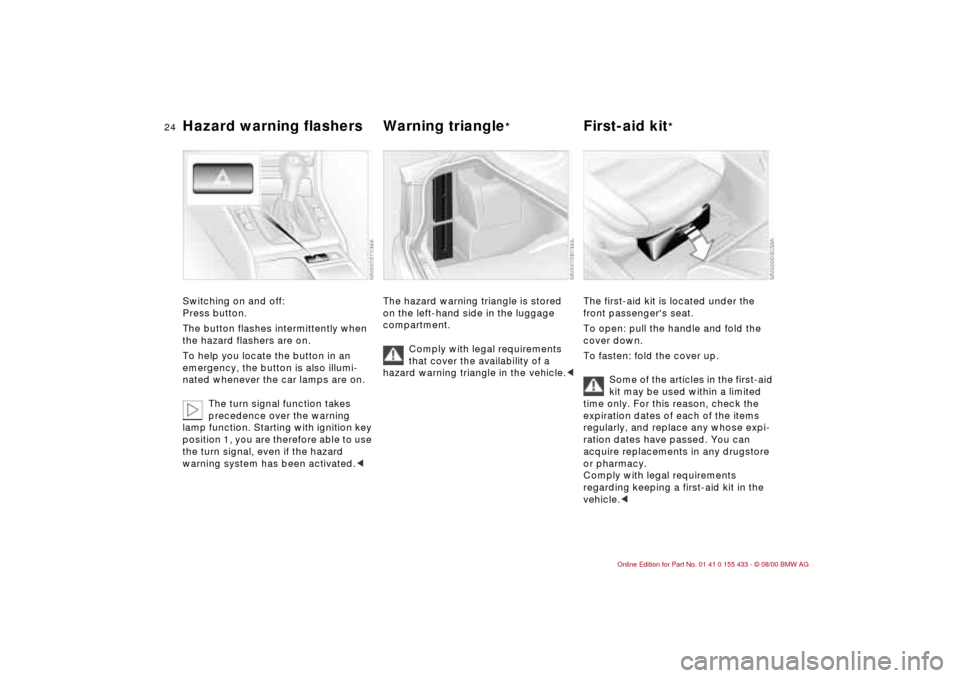
24n
Hazard warning flashers Warning triangle
*
First-aid kit
*
Switching on and off:
Press button.
The button flashes intermittently when
the hazard flashers are on.
To help you locate the button in an
emergency, the button is also illumi-
nated whenever the car lamps are on.
The turn signal function takes
precedence over the warning
lamp function. Starting with ignition key
position 1, you are therefore able to use
the turn signal, even if the hazard
warning system has been activated.<
The hazard warning triangle is stored
on the left-hand side in the luggage
compartment.
Comply with legal requirements
that cover the availability of a
hazard warning triangle in the vehicle.<
The first-aid kit is located under the
front passenger's seat.
To open: pull the handle and fold the
cover down.
To fasten: fold the cover up.
Some of the articles in the first-aid
kit may be used within a limited
time only. For this reason, check the
expiration dates of each of the items
regularly, and replace any whose expi-
ration dates have passed. You can
acquire replacements in any drugstore
or pharmacy.
Comply with legal requirements
regarding keeping a first-aid kit in the
vehicle.<
Page 25 of 183
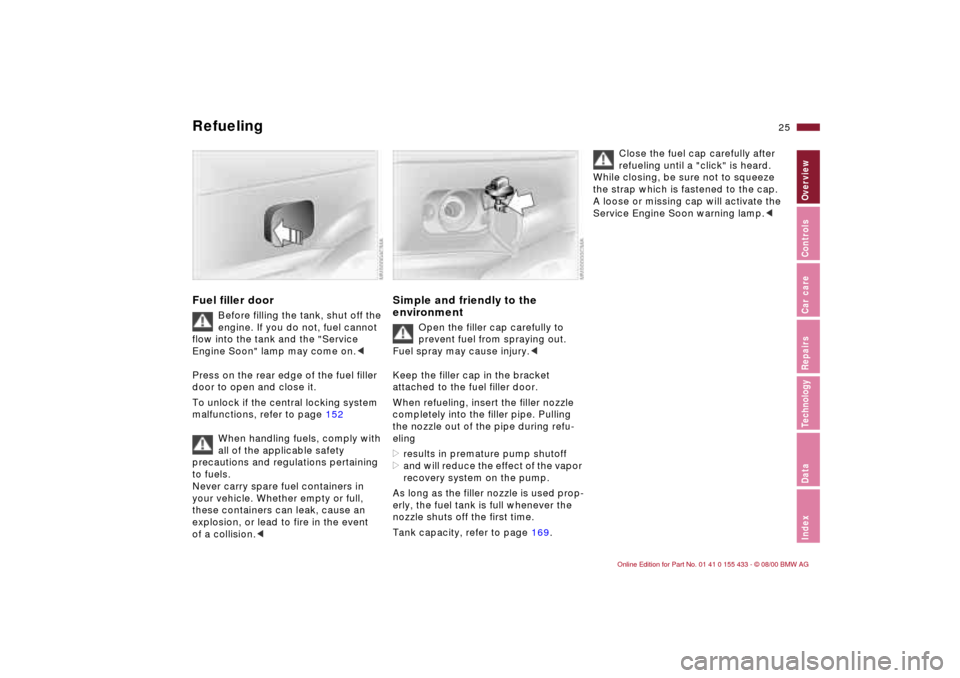
25n
IndexDataTechnologyRepairsCar careControlsOverview
Refueling Fuel filler door
Before filling the tank, shut off the
engine. If you do not, fuel cannot
flow into the tank and the "Service
Engine Soon" lamp may come on.<
Press on the rear edge of the fuel filler
door to open and close it.
To unlock if the central locking system
malfunctions, refer to page 152
When handling fuels, comply with
all of the applicable safety
precautions and regulations pertaining
to fuels.
Never carry spare fuel containers in
your vehicle. Whether empty or full,
these containers can leak, cause an
explosion, or lead to fire in the event
of a collision.<
Simple and friendly to the
environment
Open the filler cap carefully to
prevent fuel from spraying out.
Fuel spray may cause injury.<
Keep the filler cap in the bracket
attached to the fuel filler door.
When refueling, insert the filler nozzle
completely into the filler pipe. Pulling
the nozzle out of the pipe during refu-
eling
>results in premature pump shutoff
>and will reduce the effect of the vapor
recovery system on the pump.
As long as the filler nozzle is used prop-
erly, the fuel tank is full whenever the
nozzle shuts off the first time.
Tank capacity, refer to page 169.
Close the fuel cap carefully after
refueling until a "click" is heard.
While closing, be sure not to squeeze
the strap which is fastened to the cap.
A loose or missing cap will activate the
Service Engine Soon warning lamp.<
Page 26 of 183
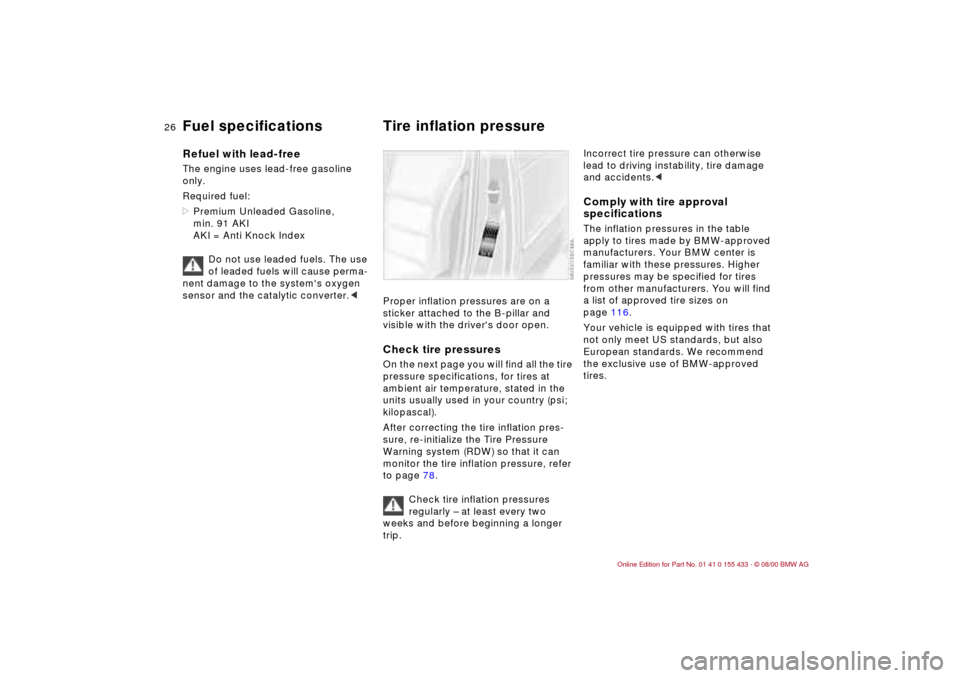
26n
Fuel specifications Tire inflation pressure Refuel with lead-freeThe engine uses lead-free gasoline
only.
Required fuel:
>Premium Unleaded Gasoline,
min. 91 AKI
AKI = Anti Knock Index
Do not use leaded fuels. The use
of leaded fuels will cause perma-
nent damage to the system's oxygen
sensor and the catalytic converter.<
Proper inflation pressures are on a
sticker attached to the B-pillar and
visible with the driver's door open.Check tire pressuresOn the next page you will find all the tire
pressure specifications, for tires at
ambient air temperature, stated in the
units usually used in your country (psi;
kilopascal).
After correcting the tire inflation pres-
sure, re-initialize the Tire Pressure
Warning system (RDW) so that it can
monitor the tire inflation pressure, refer
to page 78.
Check tire inflation pressures
regularly Ð at least every two
weeks and before beginning a longer
trip.
Incorrect tire pressure can otherwise
lead to driving instability, tire damage
and accidents.< Comply with tire approval
specifications The inflation pressures in the table
apply to tires made by BMW-approved
manufacturers. Your BMW center is
familiar with these pressures. Higher
pressures may be specified for tires
from other manufacturers. You will find
a list of approved tire sizes on
page 116.
Your vehicle is equipped with tires that
not only meet US standards, but also
European standards. We recommend
the exclusive use of BMW-approved
tires.
Page 27 of 183
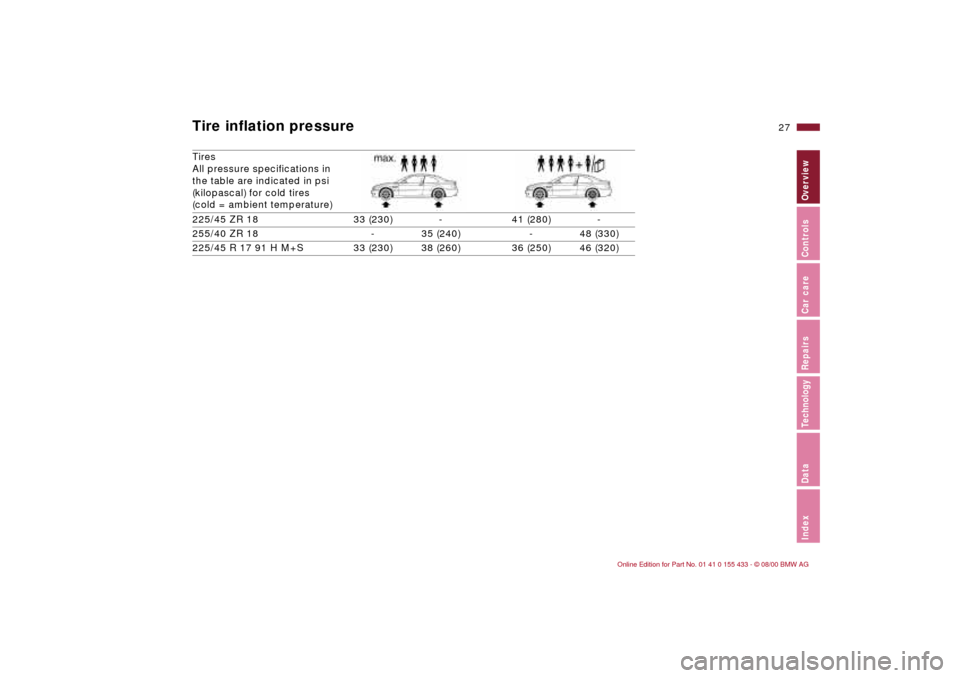
27n
IndexDataTechnologyRepairsCar careControlsOverview
Tire inflation pressure Tires
All pressure specifications in
the table are indicated in psi
(kilopascal) for cold tires
(cold = ambient temperature)
225/45 ZR 18 33 (230) - 41 (280) -
255/40 ZR 18 - 35 (240) - 48 (330)
225/45 R 17 91 H M+S 33 (230) 38 (260) 36 (250) 46 (320)
Page 28 of 183
28n
Locks and security systems:
Keys30
Electronic vehicle
immobilizer31
Central locking system31
Opening and closing Ð
via the door lock32
Opening and closing Ð
via the remote control33
Opening and closing Ð
from the inside36
Lugagge compartment lid37
Luggage compartment39
Alarm system40
Electric power windows42
Sliding/tilt sunroof43
Adjustments:
Seats45
Mirrors49
Seat and mirror memory51
Steering wheel52
Car Memory, Key Memory52
Passenger safety systems:
Safety belts54
Airbags56
Transporting children safely59
Controls
Page 29 of 183
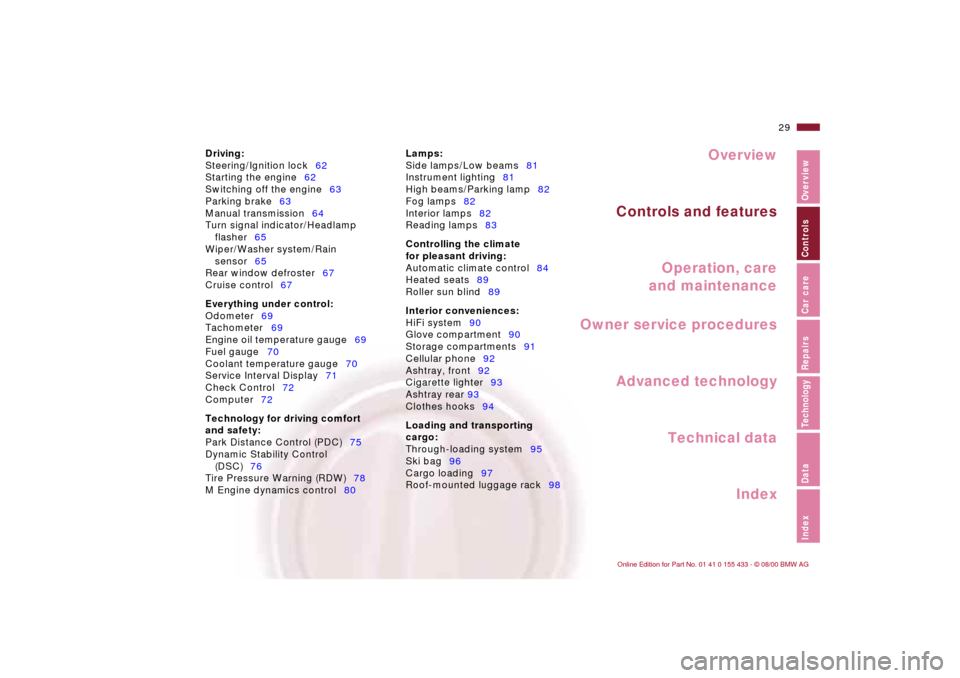
Overview
Controls and features
Operation, care
and maintenance
Owner service procedures
Technical data
Index Advanced technology
29n
IndexDataTechnologyRepairsCar careControlsOverview
Driving:
Steering/Ignition lock62
Starting the engine62
Switching off the engine63
Parking brake63
Manual transmission64
Turn signal indicator/Headlamp
flasher65
Wiper/Washer system/Rain
sensor65
Rear window defroster67
Cruise control67
Everything under control:
Odometer69
Tachometer69
Engine oil temperature gauge69
Fuel gauge70
Coolant temperature gauge70
Service Interval Display71
Check Control72
Computer72
Technology for driving comfort
and safety:
Park Distance Control (PDC)75
Dynamic Stability Control
(DSC)76
Tire Pressure Warning (RDW)78
M Engine dynamics control80Lamps:
Side lamps/Low beams81
Instrument lighting81
High beams/Parking lamp82
Fog lamps82
Interior lamps82
Reading lamps83
Controlling the climate
for pleasant driving:
Automatic climate control84
Heated seats89
Roller sun blind89
Interior conveniences:
HiFi system90
Glove compartment90
Storage compartments91
Cellular phone92
Ashtray, front92
Cigarette lighter93
Ashtray rear 93
Clothes hooks94
Loading and transporting
cargo:
Through-loading system95
Ski bag96
Cargo loading97
Roof-mounted luggage rack98
Page 30 of 183
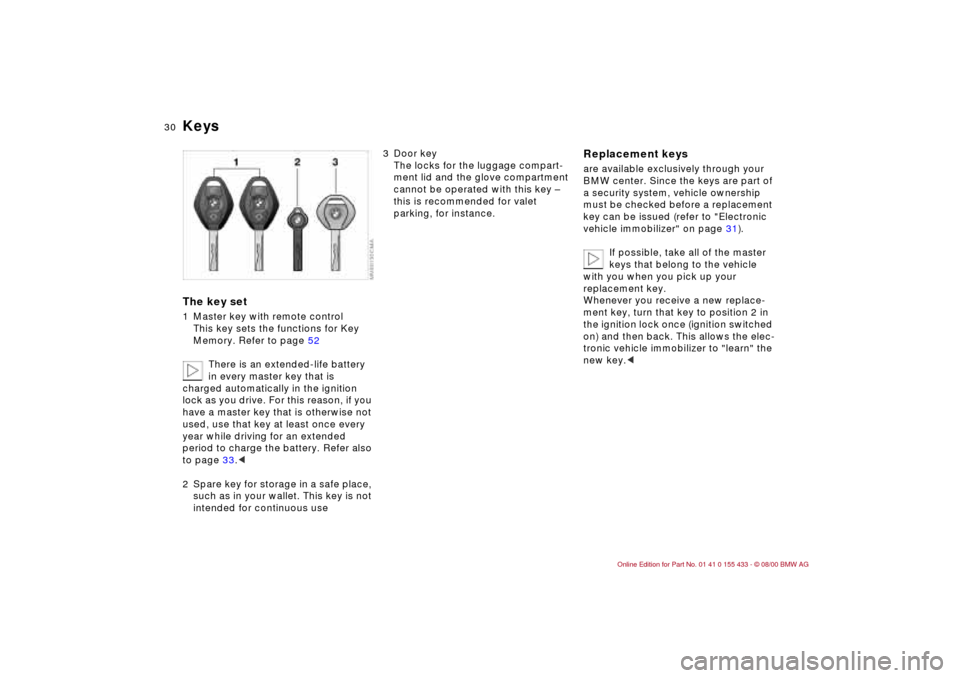
30n
KeysThe key set1 Master key with remote control
This key sets the functions for Key
Memory. Refer to page 52
There is an extended-life battery
in every master key that is
charged automatically in the ignition
lock as you drive. For this reason, if you
have a master key that is otherwise not
used, use that key at least once every
year while driving for an extended
period to charge the battery. Refer also
to page 33.<
2 Spare key for storage in a safe place,
such as in your wallet. This key is not
intended for continuous use
3 Door key
The locks for the luggage compart-
ment lid and the glove compartment
cannot be operated with this key Ð
this is recommended for valet
parking, for instance.
Replacement keysare available exclusively through your
BMW center. Since the keys are part of
a security system, vehicle ownership
must be checked before a replacement
key can be issued (refer to "Electronic
vehicle immobilizer" on page 31).
If possible, take all of the master
keys that belong to the vehicle
with you when you pick up your
replacement key.
Whenever you receive a new replace-
ment key, turn that key to position 2 in
the ignition lock once (ignition switched
on) and then back. This allows the elec-
tronic vehicle immobilizer to "learn" the
new key.<